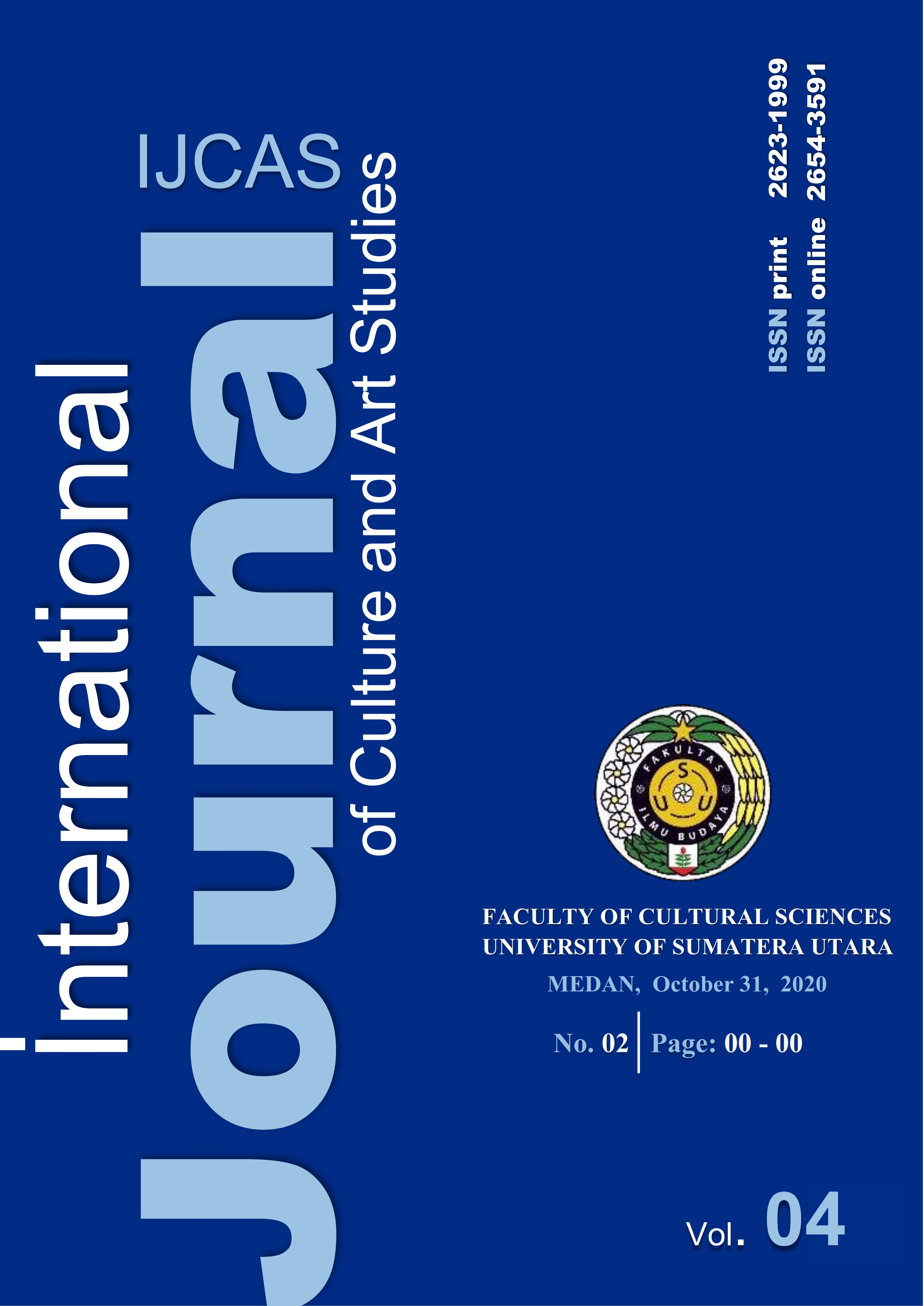The Body As Canvas As Picture
Bodypainting and its Implications for the Model
DOI:
https://doi.org/10.32734/ijcas.v4i2.4062Keywords:
Body Painting, Identity, Model, Participant Observation, Well-BeingAbstract
Body painting turns the body into a canvas – this frequently used phrase illustrates the challenge that body painting faces: It uses a three-dimensional surface and has to cope with its irregularities, but also with the model’s abilities, likes and dislikes. After giving an introduction to the art and categorizing its various types and contexts, the article focuses on the European body painting scene and on the role of the model within the scene. Although body painting can be very challenging for her – she has to expose her body and to stand still for a long time while getting transformed – models report that they enjoy the process and the result, even if they are not confident about their own bodies. A reason is that the “double staging“ – becoming a threedimentional work of art and then being staged for a photograph – remotes the body from the model and gives her the chance to see her painted body detached from herself. On the one hand, body painting closely relates to the body, on the other hand, it can help to overcome the body.
Downloads
References
J.W. Op den Akker, A. Bohnen, W.J. Oudegeest and B. Hillen , “Giving color to a new curriculum: Bodypaint as a tool in medical education,†Clinical Anatomy, vol.15, no. 5, pp. 356-362. 2002
P. G. McMenamin, “Body painting as a tool in clinical anatomy teaching,†Anatomical Sciences Education, vol. 1, no. 4, 139-144. 2008
K. Nanjundaiah and S. Chowdapurkar. Body-Painting: A Tool Which Can Be Used to Teach Surface Anatomy. Journal of Clinical & Diagnostic Research, no. 6, vol. 8: 1405-1408. 2012
R. Hitzler, T. Bucher and A. Niederbacher, Leben in Szenen, Formen jugendlicher Vergemeinschaftung heute. Wiesbaden: VS Verlag, 2005, 20.
H. Joffe, “Thematic analysisâ€, In: D. Harper and A.R. Thompson, Qualitative methods in mental health and psychotherapy: A guide for students and practitioners. Chichester: Wiley, 209-223, 209, 2011
H. Joffe, “Thematic analysisâ€, In: D. Harper and A.R. Thompson, Qualitative methods in mental health and psychotherapy: A guide for students and practitioners. Chichester: Wiley, 209-223, 211, 2011.
D. L. Altheide, “Reflections: Ethnographic content analysis,†Qualitative Sociology, Vol. 10, 65-77, 1987.
D. L. Altheide, “Reflections: Ethnographic content analysis,†Qualitative Sociology, Vol. 10, 65-77, 1987, 68.
R. Krause, Kreativität. Untersuchungen zu einem problematischen Konzept. München: Wilhelm Goldmann Verlag, 1972, 42
J. Entwistle, “Fashion and the Fleshy Body: Dress as Embodied Practice, “ Fashion Theory, vol. 4, no. 3, pp. 323-248, 2000
M. DeMello, Inked. Tattoos and Body Art around the World. Volume 1: A-L. Santa Barbara, Denver and Oxford: ABC-CLIO, 2014, 63.
P. Shukla, “The Grace of Four Moons. Dress, Adornment, and the Art of the Body in Modern India,†Bloomington: Indiana University Press, 363, 2008.
P. Scheiper, “Textile Metamorphosen als Ausdruck gesellschaftlichen Wandels“. Wiesbaden: VS Verlag für Sozialwissenschaften, 119f., 2008.
W. Leimgruber, „Die visuelle Darstellung des menschlichen Körpers. Gesellschaftliche Aus- und Eingrenzungen in der Fotografie“. In: H. Haibl and M. Gerndt: Der Bilderalltag. Perspektiven einer volkskundlichen Bildwissenschaft. Münster: Waxmann, pp. 213-232, 227, 2005.
A. Elliott, Identity Troubles: An introduction. New York: Routledge, 2016.
V. Gillies, A. Harden, K. Johnson, P. Reavey, V. Strange and C. Willig , “Women’s collective constructions of embodied practices through memory work: Cartesian dualism in memories of sweating and painâ€, British Journal of Social Psychology, Vol. 43, pp. 99-112, 100, 2004.
J. Entwistle, “Fashion and the Fleshy Body: Dress as Embodied Practice, “ Fashion Theory, vol. 4, no. 3, pp. 323-248, 2000 325
K. Jettmar, “Body-painting and the Roots of the Scytho-Siberian Animal Styleâ€, In B. Genito: The Archeology of the Steppes. Methods and Strategies. Napoli: Estratto, pp. 3-25, 6, 1994.
J. Park, “A Study on Body Painting according to Physical Types,†Journal of Fashion Business, vol. 19, no. 5, pp. 175-187.
M. DeMello, Inked. Tattoos and Body Art around the World. Volume 1: A-L. Santa Barbara, Denver and Oxford: ABC-CLIO, 63, 2014, 63.
C. Beckwith, African Ceremonies. New York: Harry N. Abrahams, Inc., 199, 1990
M. Fortin, Takona. “Bodypainting in Rapa Nui Performing Arts, “ Australian Drama Studies, vol. 55, pp. 150-163.
M. DeMello, Inked. Tattoos and Body Art around the World. Volume 1: A-L. Santa Barbara, Denver and Oxford: ABC-CLIO, 63, 2014, 64
M. von Matuschka, Bodypainting. Fantastische Gesichter. Ravensburg: Ravensburger Verlag, 1999.
S. A. Fedorak, Pop Culture. The Culture of Everyday Life. Toronto: University of Toronto Press, 2009, 73
A. Fisher, Africa Adorned. New York: Harry N.Abrahams, Inc.,1990, 270.
K. N. Fayers-Kerr, “The ‘Miranda‘ and the ‘Cultural Archive‘. From Mun (Mursi) lip-plates, to bodypainting and back again,†Paideuma, no. 58, pp. 245-259, 2012, 245.
E. M. Matike, V. E. Ngole, M.P. Mpako and G.I. Ekosse , “Ceremonial usage of clays for body painting according to traditional Xhosa cultureâ€, Indilinga African Journal of Indigenous Knowledge System, vol. 10, no. 2, pp. 235-244, 2011.
S. A. Fedorak, Pop Culture. The Culture of Everyday Life. Toronto: University of Toronto Press, 2009, 73.
M. DeMello, Inked. Tattoos and Body Art around the World. Volume 1: A-L. Santa Barbara, Denver and Oxford: ABC-CLIO, 2014, 63.
S. A. Fedorak, Pop Culture. The Culture of Everyday Life. Toronto: University of Toronto Press, 2009, 73.
World Intellectual Property Organization, Intellectual Property and Folk, Arts, and Cultural Festivals. Geneva: WIPO, 2018, 39
S. A. Fedorak, Pop Culture. The Culture of Everyday Life. Toronto: University of Toronto Press, 2009, 73.
M. DeMello, Inked. Tattoos and Body Art around the World. Volume 1: A-L. Santa Barbara, Denver and Oxford: ABC-CLIO, 2014, 63.
M. Jerrentrup, Therapie vor der Kamera? Zum Potential inszenierter Menschenfotografie. Münster: Waxmann, 2018, 53.
K. Nanjundaiah and S. Chowdapurkar, “Body-Painting: A Tool Which Can Be Used to Teach Surface Anatomy, “Journal of Clinical & Diagnostic Research, vol. 6, no., pp. 1405-1408, 2012
J. Entwistle, “Fashion and the Fleshy Body: Dress as Embodied Practice, “ Fashion Theory, vol. 4, no. 3, pp. 323-248, 2000, 326.
E. K. Katic, “The Living Canvas: Bodies that Serve and Simulate Art, “ The American Journal of Semiotics, vol. 25, no. 1/2, pp. 77-101,2009, 77.
P. Hershman, Hair, Sex and Dirt. Man, New Series, vol. 9, 1974, 274.
M. DeMello, Inked. Tattoos and Body Art around the World. Volume 1: A-L. Santa Barbara, Denver and Oxford: ABC-CLIO, 2014, 67.
H. Beloff, “Social Interaction in Photography,†Leonardo, vol. 16, no. 3, pp. 165–171, 1983,171.
E. K. Katic, “The Living Canvas: Bodies that Serve and Simulate Art, “ The American Journal of Semiotics, vol. 25, no. 1/2, pp. 77-101,2009, 77.
Schönhuth, Michael, Vademecum durch den Kulturdschungel. Eschborm: GTZ, 2015, 91.
T. Henning, “Personale Identität und personale Identitäten – Ein Problemfeld der Philosophie“, In H. G. Petzold, Identität. Ein Kernthema moderner Psychotherapie – Interdisziplinäre Perspektiven. Wiesbaden: VS Verlag, pp. 19-38, 2012, 21.
A. Elliott, Identity Troubles: An introduction. New York: Routledge, 2016, 17.
N. Degele, Sich schön machen. Zur Soziologie von Geschlecht und Schönheitsidealen. Wiesbaden: VS Verlag, 2004, 16.
H. Morphy, “Moving the body painting into the art gallery – knowing about and appreciating works of Aboriginal art,†Journal of Art Historiography, vol. 4, pp. 1-20, 2011, 17.
M. DeMello, Inked. Tattoos and Body Art around the World. Volume 1: A-L. Santa Barbara, Denver and Oxford: ABC-CLIO, 2014, 67.
M. Weiss, “Was ist ‚inszenierte Fotografie‘? Eine Begriffsbestimmung.“ In: Lars Blunk: Die Fotografische Wirklichkeit. Inszenierung. Fiktion. Narration. Bielefeld: Transcript, pp. 37–52, 2010, 50.
M.T. Jerrentrup, “Kein Fokus auf das Foto. Fotografieren als Aktivität“, kommunikation@gesellschaft 21, 2020.
Eberle, Thomas, Fotografie und Gesellschaft. Phänomenologische und wissenssoziologische Perspektiven. Bielefeld: transcript, pp. 11-72, 2017.
Fischer and Wiswede, Grundlagen der Sozialpsychologie. München: Oldenbourg, 2009, 100.
C. Mundt, “Neurobiologische Aspekte kreativer Therapie“, in: R. Hampe, P. Martius, D. Ritschl, F. von Spreti and P. B. Stadler: KunstReiz. Neurobiologische Aspekte künstlerischer Therapien. Berlin: Frank & Timme, pp. 91–104, 2009, 97.
M. Schuster, Alltagskreativität. Wiesbaden. Springer, 2015, 50.
R. Barthes, Die helle Kammer. Bemerkungen zur Photographie. Stuttgart: Suhrkamp. 1989, 89.
E. K. Katic, “The Living Canvas: Bodies that Serve and Simulate Art, “ The American Journal of Semiotics, vol. 25, no. 1/2, pp. 77-101,2009, 77.
M. DeMello, Inked. Tattoos and Body Art around the World. Volume 1: A-L. Santa Barbara, Denver and Oxford: ABC-CLIO, 2014, 63.
Downloads
Published
How to Cite
Issue
Section
License
Copyright (c) 2020 Maja Tabea Jerrentrup

This work is licensed under a Creative Commons Attribution-ShareAlike 4.0 International License.













